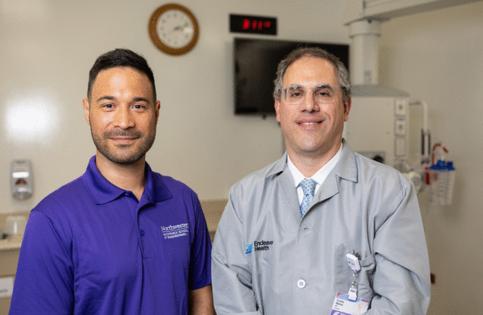Researchers at Endeavor Health, Northwestern create AI tool to help identify dangerous respiratory syndrome
Published in Health & Fitness
Researchers at Endeavor Health and Northwestern University have created an artificial intelligence-based tool to help doctors recognize an underdiagnosed, often fatal respiratory syndrome found in critically ill hospital patients. The tool has already identified historical cases with 93% accuracy, and it will soon be piloted for patients in treatment at Endeavor.
Acute respiratory distress syndrome, or ARDS, happens when the lungs become severely inflamed — much more so than from a typical lung infection. This inflammation leads to extensive damage, causing fluid to leak from other parts of the lung into the air sacs. Because of this fluid buildup, patients can’t get oxygen into their bloodstream.
It’s often referred to as a sort of “drowning on dry land,” where the body’s own immune system fills the lungs with fluid. Félix Morales, the lead data scientist on the project, described it as “leaks from your own circulatory system into the lungs.”
ARDS has a very high mortality rate, with up to 46% of patients dying from the condition. For those who survive, it often means permanent scarring in the lungs, or cognitive impairments due to prolonged lack of oxygen. It can be triggered by many different medical conditions, but is often seen in people who are already critically ill with conditions like sepsis or pneumonia. It’s also a primary cause of death in COVID-19 patients.
“During the first year of the pandemic, we had otherwise healthy-appearing 20-year-olds and 30-year-olds who were dying from ARDS as a result of severe COVID,” said Dr. Curtis Weiss, an Endeavor Health pulmonologist and co-director of critical care medicine. He has been working on this problem since 2018, and was part of the team that created the machine learning tool to recognize the signs of ARDS in patients.
This is not generative AI like ChatGPT — there is no way for it to create new information and “hallucinate” data that isn’t real. Instead, it will look at the information already available to doctors in patients’ medical records, such as lab results and imaging. The end result, the team hopes, will be an automated review system watching out for signs of ARDS in patients. The system won’t diagnose patients with ARDS — it will let doctors know that their patients may be suffering from it, and suggest they look from that angle.
Weiss learned early in his career that ARDS is underdiagnosed, both because of its many potential causes and because it is easily mistaken for other conditions. In order to diagnose ARDS, doctors have to observe many factors, such as oxygen levels, chest X-rays, and whether the patient has another condition such as sepsis or pneumonia that is known to trigger ARDS.
“My hypothesis is that one of the reasons for the under-recognition is that the physician is not integrating those various different parts of the diagnosis,” Weiss said. Doctors in ICU settings are under an “information overload” from dozens of critically ill patients each day, so it’s no surprise that the perfect storm of factors for ARDS might be missed by even the most competent of doctors.
Knowing that ARDS is the reason the lungs are obstructed, however, can significantly change the way patients are treated.
Weiss used the example of congestive heart failure, which presents very similarly to ARDS. Congestive heart failure can also cause fluid buildup in the lungs, but the fluid comes from the heart’s inability to pump blood effectively, not lung inflammation causing damage.
If fluid in a patient’s lungs is making them unable to breathe, a doctor may put them on a ventilator; the specific operation of the ventilator, however, is different for congestive heart failure and ARDS. Furthermore, studies have shown that placing a person with ARDS on their stomach helps their lungs clear fluid better. In patients with congestive heart failure, this kind of posture could put too much strain on the heart.
“Sometimes that means that we underrecognize something as severe as ARDS because it requires picking out the right information and putting it all together in the right sequence at the right time to say, OK, this patient has ARDS,” Weiss said. If there was a computer program that could put these pieces together and alert doctors when they’re all in place, more ARDS cases could be diagnosed and treated.
The next step for the team is to see if it can identify ARDS in patients who are currently in the hospital, in essence predicting the diagnosis before it’s made by a doctor.
Right now, the tool has only been used on medical cases that have already been resolved — patients who came in sick and were diagnosed with ARDS. The tool positively identified 93% of cases, with false positives only 17% of the time. The team said they can adjust the tool to have fewer false alarms, but given the severity of the condition, they’d rather it flag patients who are safe than miss patients who aren’t.
“I would rather treat all the ARDS patients and then a few others that may not have ARDS, as opposed to not treating a certain portion of patients who actually do have ARDS,” Weiss said. “We’re trying to solve an ARDS under-recognition problem.”
_____
©2025 Chicago Tribune. Visit chicagotribune.com. Distributed by Tribune Content Agency, LLC.










Comments